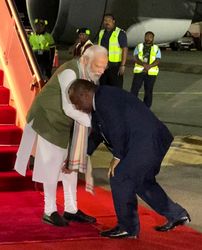India put its best foot forward in the Pacific last year. Some 600 Fijians were fitted with the Jaipur foot that enabled them to walk. One more prosthetic camp is being planned in Papua New Guinea this year. Next year on, there will be two camps every year in any two of the 14 Pacific isles which are members of the Forum for India-Pacific Islands Cooperation (FIPIC) initiative.
Not just the foot; India is also putting its fingers in the Pacific pie. We gave Fiji and Papua New Guinea’s election managers about 22,000 pots of indelible ink, a unique Indian innovation by which a voter’s forefinger is stained to indicate that he has voted.
The sun signs in the east are clear—India is returning to the Pacific.
Returning? Were we there ever? Of course, we were there more than three quarters of a century ago—may not be in any of the 14 FIPIC states, but in the region as the guardians of the east. Believe me, it took the mighty Japanese army 18 days of fierce hand-to-hand fighting to dislodge a few hardy Punjabis and Rajputs from their Hong Kong garrison, before they could conquer the Pacific in the winter of 1941-42.
Perhaps, the first military man who recognised the strategic value of the islands after the Japanese conquest of the Pacific was Douglas MacArthur. The Yankee general devised the leap-frogging or island-hopping strategy to kick out the Japanese from island after island. Remember, when he had to leave the Leyte Island he had said, “I shall return”. And he did. There is an iconic photo of the dashing general wading through the beach waters on his triumphant return.
These isles offered little strategic value to anyone since then. The Europeans lost their empires, the Japanese made friends with the west, the Americans and the Russians stayed focused on waging a cold war on the continents, and the Chinese remained looking inward with their long marches, cultural revolutions and modernisations. The Pacific isles mattered little, except to the world’s botanists, zoologists and philatelists—some of the island countries produced the flashiest of postage stamps depicting their rich flora and fauna, which collectors bought at a hundred times their face value. Yes, indeed, a few of them—the Cook Islands, Fiji, Kiribati, Nauru, Papua New Guinea, Tonga, and Vanuatu—also helped make up the numbers in Commonwealth Games and gatherings.
The eastern world has turned topsy-turvy since. Old enemies are friends now; some of the old friends are now turning enemies or rivals. With the Chinese seeking to set new rules of oceanic navigation, and sending warships into our backwaters, we have been forced for a while to look east and act east, and develop strategic counter-stakes in the Pacific. Indeed, acquiring capabilities to strike at Shanghai is not the idea now, but we have realised that, apart from the Quad of the US, Japan and Australia, we need small friends in the east who can be wooed by projecting our soft power.
Thus, last week, Narendra Modi became the first Indian prime minister to set foot in Papua New Guinea. There he addressed the third conclave of the 14 island states, and offered them sea ambulances, dialysis units, yoga centres, Jan Aushadhi Centres which would provide cheap generic drugs, and also to train 1,000 cyber techies in the next five years. He also plans to give them machinery for small factories, set up plants on all isles to make drinking water out of sea water, and install solar power panels atop the homes of a few of their presidents and prime ministers.
Enough to leave our stamp there.
prasannan@theweek.in


